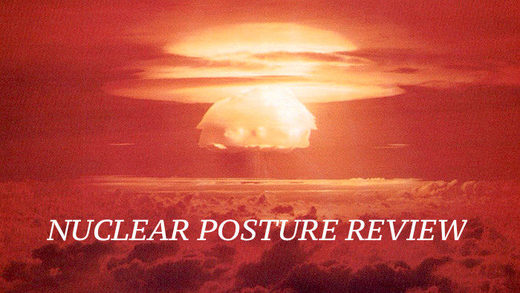EDITOR’s NOTE: This is a Press Release issued earlier today by Greg Mello of the Los Alamos Working Group
Contact: Greg Mello, 505-265-1200 office, 505-577-8563 cell
Permalink * Prior press releases
Albuquerque, NM — Today the Department of Defense (DoD) released its long-awaited National Defense Strategy (NDS), Nuclear Posture Review (NPR), and Missile Defense Review (MDR).
In the interest of time, this press release addresses the NPR only. Detailed comparison with past NPRs will also need to come later, as may be warranted.
A classified version of the NPR has long been available to Congress and has helped shape this year’s draft authorization and appropriations bills.
Before proceeding it is important to note that the central concept in this document, “nuclear deterrence,” implies the threatened use of nuclear weapons. To deter, the nuclear threat must be credible, i.e. real. In all the contexts where this NPR speaks of “nuclear deterrence,” threatened nuclear use is implied. They are synonymous.
There are no great surprises in this NPR, which generally tracks long-standing U.S. policies, the public congressional testimony of administration officials, and the administration’s fiscal year 2023 (FY23) budget request.
As expected, this NPR would cancel the sea-launched cruise missile (SLCM-N) and retire the megaton-class B83-1 bomb (p. 20).
In the case of the SLCM-N, the cost of designing and producing the new missile and its associated warhead was quite high (p. 20). In addition, sources tell us that a Navy Analysis of Alternatives (AoA) of SLCM-N was highly negative. Also, as the NPR reports, the low-yield W76-2 warhead — deployed on Trident ballistic missiles in Ohio-class submarines — was judged adequate for tactical deterrence, along with the B61-12 air-delivered nuclear bomb, delivered by the F-35A dual-capable aircraft (DCA), and the nuclear-tipped Long Range Stand Off (LRSO) air-launched cruise missile, to be delivered by B-52H bombers and new B-21 “Raider” bomber currently in development.
The B83-1 bomb is to be retired “due to increasing limitations on its capabilities and rising maintenance costs” (p. 20 again). Its nuclear mission — attacking (“holding at risk”) deeply-buried targets — is to be accomplished by existing bombs (i.e. the B61-11, not mentioned) and by unstated new capabilities to be developed by “DoD and its interagency partners.” As to what the “increasing limitations on [B83-1] capabilities” may be we can only speculate at this point, noting that the roughly 16 soon-to-retire B-2A (“Spirit”) bombers are currently the only delivery vehicles for this bomb.
***
Apart from these expected elements, the Biden nuclear posture review provides crystal clarity in its rejection of “No First Use” and “Sole Purpose” policies, both of which “would result in an unacceptable level of risk in light of the range of non-nuclear capabilities being developed and fielded by competitors that could inflict strategic-level damage” to the US and allies (p. 9).
A “sole purpose” policy is one that would use nuclear weapons to deter or retaliate after nuclear attacks only. This NPR affirms that U.S. nuclear deterrence applies to “allforms of strategic attack,” not just nuclear attacks, as one of the three roles listed for U.S. nuclear weapons (p. 7, emphasis added).
The other two purposes are to “assure allies and partners,” and to “achieve U.S. objectives if deterrence fails” — i.e. to win wars, including nuclear wars.
These policies support a posture of U.S. nuclear threats to prevent regional nuclear coercion, as well as the use of so-called “tactical” nuclear weapons to prevent military defeat and “defend the vital interests of the United States or its Allies and partners” (p. 9).
This NPR affirms that the U.S. “will not intentionally target civilian populations or objects” (p. 8, emphasis added). What this might actually mean for nuclear targeting is unknown to all but a very few in government.
Of particular interest, this NPR would create a new “three pillar” plan for the nuclear weapons enterprise (p. 23), consisting of a:
- “Nuclear Deterrent Risk Management Strategy to identify, prioritze, and recommend actions…with the goal of enhancing senior leader visibility and framing options for risk mitigation”; a
- “Production-based Resilience Program (PRP) to…ensure that the nuclear security enterprise is capable of full-scope production” and is “sufficiently resilient to adapt to additoinal or new requirements;” and a
- “Science and Technology Innovation Initiative to accelerate the integration of science and technology.”
Plutonium warhead core (“pit”) production “will also allow new pit designs to be manufactured if necessary for future weapons,” while “[t]he two-site strategy at Los Alamos National Laboratory and the Savannah River Site will eliminate single point failure and provide flexible capacity options.” (p. 24)
Study Group director Greg Mello:
“This Nuclear Posture Review is more hawkish than Biden’s prior expressed views. It reflects the vested power of neoconservatives and a powerful nuclear “deep state” encompassing specially privileged parts of the executive branch, powerful nuclear weapons contractors, and a supportive Congress.
“While in the main expressing continuity with past policy, this NPR codifies most of the worst nuclear impulses currently to be found in the U.S. government.
“The only bright lights seem to be cancellation of the SLCM-N, which was driven by the Navy’s practical concerns, and the cancellation of the B83-1, which was also driven by practical realities.
“There is no disarmament in this document. What little attention is given to arms control is contradictory to the main thrust of the document.
“There is a constitutional question as to whether the president can make nuclear weapons policies unilaterally. I believe he or any president can. Many in Congress believe otherwise.”




